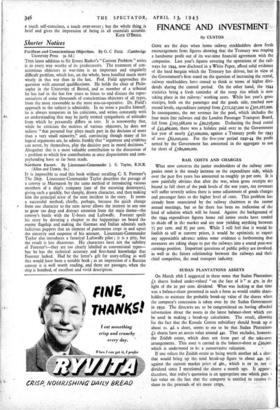FINANCE AND INVESTMENT
By CUSTOS
GONE are the days when home railway stockholders drew fresh encouragement from figures showing that the Treasury was reaping a handsome profit out of its war-time financial agreement with the companies. Last year's figures covering the operations of the rail- ways for 1944, now disclosed in a White Paper, afford solid evidence of the hard bargain which the Treasury has driven, but in view of the Government's firm stand on the question of increasing the rental, railway stockholders have ceased to think in terms of higher divi- dends during the control period. On the other hand, the 1944 statistics bring a fresh reminder of the steep rise which is now taking place in the railways.' working costs. While last year's gross receipts, both on the passenger and the goods side, reached new record levels, expenditure jumped from £272,247,000 to £301,167,000. In consequence, the net revenue for the pool, which includes the four main line railways and the London Passenger Transport Board, fell from £105,568,000 to £90,256,000. Deducting the fixed rental of £43,469,000, there was a balance paid over to the Government last year of nearly £47,000,000, against a Treasury profit for 1943 of over L62,000,000. For the five-year period 1940-44 the profit netted by the Government has amounted in the aggregate to not far short of L18o,000,000.
RAIL COSTS AND CHARGES What now concerns the junior stockholders of the railway com- panies most is the steady increase on the expenditure side, which over the past five years has amounted to roughly 5o per cent. It is now painfully obvious that after the war, when gross receipts are bound to fall short of the peak levels of the war years, net revenues will suffer severely unless there is some adjustment of goods charges and passenger fares to the higher level of costs. This problem has already been enunciated by the railway chairmen at the recent annual meetings, but so far there has been no indication of the kind of solution which will be found. Against the background of the 1944 expenditure figures home rail junior stocks have tended to shade off in the market and are now yielding anything between 71 per cent. and 81 per cent. While I still feel that it would be foolish to sell at current prices, it would be optimistic to expect any appreciable advance unless some evidence is forthcoming that measures are taking shape to put the railways into a sound post-war earnings position. Important questions of public policy are involved. as well as the future relationship between the railways and their chief competitor, the road transport industry.
SUDAN PLANTATIONS ASSETS 1
On March 16th I suggested in these notes that Sudan Plantations Li shares looked under-valued "on the face of it " at 47s. in the
light of the 20 per cent. dividend. What was lacking at that time was a balance-sheet presented in such a form as would enable share- holders to estimate the probable break-up value of the shares when the company's concession is taken over by the Sudan Government in 195o. The directors are to be congratulated on having afforded information about the assets in the latest balance-sheet which can be used in making a break-up calculation. The result, allowing for the fact that the Kassala Cotton subsidiary should break up at about is. 4d. a share, seems to me to be that Sudan Plantations LI shares have an assets value around 44s. That excludes, however, the Zeidab estate, which does not form part of the take-over arrangements. This asset is carried in the balance-sheet at £90,000. which is understood to be a conservative valuation. fi If one values the Zeidab estate as being worth another 9d. a sitar.- that would bring up the total break-up figure to about 44s. 9d against the current market price of 465., which is ex 2S. net 0: dividend since I mentioned the shares a month ago. It appear. therefore, that today's quotation is an appropriate one which puts fair value on the fact that the company is entitled to receive it share in the proceeds of six more crops.


























 Previous page
Previous page